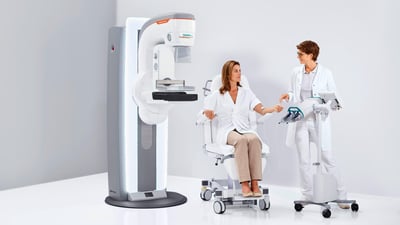 Breast cancer is the second most common cancer among women in the United States. Currently, it accounts for nearly 30% of all new female cancers each year. For 2023, the American Cancer Society estimated that 297,790 new cases of invasive breast cancer would be diagnosed and about 43,700 women would die from breast cancer.
Breast cancer is the second most common cancer among women in the United States. Currently, it accounts for nearly 30% of all new female cancers each year. For 2023, the American Cancer Society estimated that 297,790 new cases of invasive breast cancer would be diagnosed and about 43,700 women would die from breast cancer.
Despite the high number of diagnoses, the death rate from breast cancer has been decreasing steadily in the US since 1989. This is due to a number of factors, including earlier detection through screening and improved treatments.
Today, the five-year relative survival rate for women with invasive breast cancer is now 90.8%. In an even better sign of progress, the American Cancer Foundation notes that, when caught in its earliest, localized stages, the five-year relative survival rate is 99%.
Progress in Breast Cancer Diagnosis and Treatment
The US has made significant strides in the diagnosis and treatment of breast cancer in recent decades. For example, mammography screening has become more widespread, and new imaging technologies, such as breast MRI, have made it possible to detect breast cancer earlier.
New treatments have also been developed, including more targeted therapies and immunotherapy. These treatments are often more effective and have fewer side effects than traditional treatments, such as chemotherapy and radiation therapy.
Mammography Quality Standards Act
The Mammography Quality Standards Act (MQSA) was enacted in 1992 in response to growing concerns about the quality of mammography services in the United States. In fact, prior to the passage of MQSA, there were no federal, comprehensive quality standards for mammography that applied to all imaging providers.
During the early 1990s, a string of news reports and government investigations heightened concerns about false-negative mammograms, radiation overexposure and other problems. These reports led to public complaints and calls for legislative reform.
With the passage of the Mammography Quality Standards Act, it was mandated that all mammography facilities be certified by an FDA-approved accreditation body and to comply with FDA regulations.
2023 Update to the Mammography Quality Standards Act
In March 2023, the FDA announced changes to the Mammography Quality Standards Act to reflect advances in mammography technology and improve the quality of mammography services. Healthcare imaging providers have until August 2024 to fully implement these new regulations. They include:
- Breast density notification: Mammography facilities are now required to notify patients of their breast density and explain the implications for breast cancer screening.
- Image quality standards: Mammography facilities must use standardized compression and image display techniques to ensure higher image quality.
- Personnel training requirements: Mammography personnel are expected to receive initial and continuing training in scan quality assessment and breast density interpretation.
- Mammography reporting: Mammography facilities will now report mammogram results in a more standardized format.
Breast Density Notification
The American Cancer Society describes breast density as a measure of how much of the breast is made up of fibrous and glandular tissue. Women with dense breasts have a higher risk of developing breast cancer and are also more likely to have false-negative mammograms.
The new breast density notification requirements are designed to educate and empower women, enabling informed healthcare decision-making.
Image Quality Standards
The updated image quality standards are intended to improve the accuracy and reliability of mammograms. The new standards include requirements for:
- Breast compression: Updated regulations dictate that mammograms should be taken with greater breast compression, which can help to improve image quality.
- Image display: Mammogram images must now be displayed in a standardized format, which can help radiologists interpret them more accurately.

Personnel Training Requirements
Mammography personnel must now receive additional training in breast density interpretation and other areas. This training is meant to help mammographers recognize and interpret breast cancer more accurately, as well as identify patients who face a greater risk of developing breast cancer in the future.
Mammography Reporting
Mammography facilities must now report results using a national dense breast reporting standard when sharing findings with other healthcare providers and in letters to patients. This will make it easier for patients to understand their mammogram results and to compare results from different providers over time.
Value to Patients and Providers
The recent changes to the Mammography Quality Standards Act will add value to patients in a number of ways, including:
- More accurate mammograms: The new image quality standards and personnel training requirements are designed to improve the accuracy and reliability of mammograms. This will help reduce the number of false-negative mammograms and ensure more breast cancers are detected early.
- Better patient-provider communication: The new breast density notification requirements will help women understand their risk of breast cancer and improve informed decision-making when considering breast cancer screening. Similarly, the new standardized reporting requirements will make it easier for patients to compare mammogram results over time, from one facility to another.
- Reducing healthcare costs: The new changes to the Mammography Quality Standards Act are expected to have a positive impact on healthcare costs and savings. By detecting more breast cancers early, the new regulations can help reduce the need for more expensive and invasive treatments later on.
The 2023 updates to the Mammography Quality Standards Act are a positive development for the fight against breast cancer. The new requirements for breast density notification, image quality standards, personnel training, and mammography reporting will help improve the accuracy and reliability of mammograms, leading to earlier detection of breast cancer and better outcomes for patients.
These changes also highlight how quickly and dramatically new diagnostic tools and technology can alter the standard of care. As healthcare technological developments only gain in speed and frequency, regulatory bodies and programs like the MQSA will likely be expected to evolve with similar alacrity.






Comments